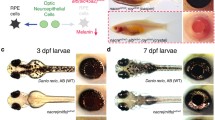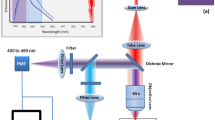Abstract:
In zebrafish (Danio rerio) pigmentation is initiated during embryogenesis and begins in the retinal epithelium and in the melanophores. The pigment cells develop rapidly, and within hours they constitute a prominent feature of the embryo. In order to improve signal detection by whole mount in situ hybridization, confocal microscopy, or expression of GFP, embryos may be treated with 1-phenyl 2-thiourea (PTU) during embryogenesis. PTU inhibits melanogenesis by blocking all tyrosinase-dependent steps in the melanin pathway but can be toxic at high concentrations. The embryos remain transparent as long as the PTU treatment is continued. However, PTU treatment must be initiated before the initial pigmentation because it does not remove already formed pigment. Here we provide a protocol for generating transparent zebrafish while avoiding the toxic and teratogenic effects of PTU treatment.
Similar content being viewed by others
Author information
Authors and Affiliations
Additional information
Received December 4, 2000; accepted April 7, 2001.
Rights and permissions
About this article
Cite this article
Karlsson, J., von Hofsten, J. & Olsson, PE. Generating Transparent Zebrafish: A Refined Method to Improve Detection of Gene Expression During Embryonic Development. Mar. Biotechnol. 3, 522–527 (2001). https://doi.org/10.1007/s1012601-0053-4
Issue Date:
DOI: https://doi.org/10.1007/s1012601-0053-4




